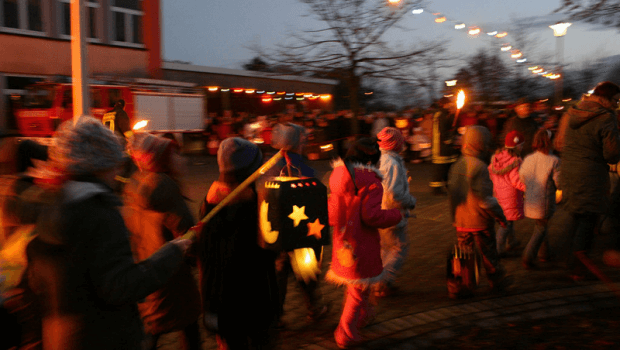
Martinsumzug: Time of Culture, Bonfires, Food and Sacrifice
Martinsumzug is also known as Saint Martin’s Day in the Anglophone world and is religiously observed on the 11th of November each year rejoicing in the modesty and altruism of St. Martin of Tours. The day holds particular popularity among the children. Traditionally speaking, the day is thus a public holiday primarily because a prolonged fast is observed from this day onwards until the day of Christmas.
The day is considered holy and pious and was originally celebrated in the Catholic dominated areas of Germany and Austria among other European regions. Today, however, the day is also observed among the protestant communities across regions. Furthermore, this day also marks the beginning of the Advent season which is then followed by Nikolaustag, Weihnachten, and Dreikonigstag.
You can find this day being celebrated with parades carrying lanterns during the evening. Children usually carry their own handmade lighted lanterns and walk along by singing the traditional songs of the season. More often than not one can also spot people dressed as Roman soldiers who are generally on horseback walking alongside the parade.
In his formative years, St. Martin was a soldier in the Roman army but was baptised later on he became a monk. His kindness and virtuous form of living have been inspiring everyone to live a simple living. St. Martin’s life itself is surround by numerous legends, the most popular among them dates back to the time when he divided his cloak in half so that he could share the other half with a beggar while a heavy snowstorm was underway. Later that night he dreamt of Jesus who appeared wearing the other half of the cloak and said to an angel that – “Here is Martin, the Roman soldier who is not baptised; he has clothed me.”
Martinsumzug also falls along the autumn wheat seeding season along with the slaughtering of the ready cattle. The beef that is produced out these cattle’s is known as – Martinmas beef.
The Cultural Significance and Developments
The year 316 A.D. is marked as the year of birth of St. Martin. The patron saint of the children and the poor is said to have taken birth in present-day Hungary and then moved to Italy and France. Also, the saint is believed to have joined the Roman army as a young teenager with a passionate desire to become a soldier just like his father.
There is a bit of historical discrepancy, but the larger belief holds that this day, in fact, spread from England, then to Germany, Scandinavia and then finally moving further in the east of Europe.
In Europe, the following time around the month of November is important because it marks the end of the agrarian year and the harvesting of the years grain thus begins.
The Bishop of Tours, Perpetuus (death. A.D. 490) had decreed that all the Christians must fast for three days in the week beginning from St. Martin’s day that is 11th November onwards. By the time the 6th century approached, the local council had further decreed that fasting should be observed on all the days apart from the Saturdays and Sundays from that day onwards till the 6th of January which was then the feast of baptism. This arrangement is quite similar to the fasting that is observed during Lent. Therefore, it was also otherwise known as – Quadragesima Sancti Martini or Saint Martin’s Lent. In the due course, the church interfered and shortened the 40 days of fasting and rechristening it as Advent.
The roots of the tradition
The various customs of the season are based on two different instances. Interestingly, it was only in the 19th century that the various traditions were contextualised with the symbol of St. Martin. The day of St. Martin with respect to the agricultural calendar marks the beginning of the winter season. On the other hand, as per the economic calendar, the day marks the end of autumn. Additionally, this time of the year is also significant because it accords with the harvesting season along with the end of the Octave of All Saints. This is also an important season economically because it is at this time that the newly produced wine is ready for the market along with the different kinds of preparations for the beginning of winters such as butchering of animals. As far as the feast of St. Martins is concerned it holds significant similarities with the Thanksgiving of the Americas. Among the various German regions, the season is like a mini carnival wherein one feast by sitting beside the bonfire.
Martinsumzug is often celebrated in other countries precisely on the eleventh minute of the eleventh hour of this eleventh day of the eleventh month. There are those regions as well wherein the festivities commence on the eve of the Day itself that is on the 10th of November. Children have a great time especially because they build the bonfire and typically carry a lantern and then go on parades across the streets in the after dark hours while singing songs and then receiving rewards in the form of candies.
The German way
In Germany, the season is marked by a customary bonfire which is lit on the eve of the Martinsumzug. These processions have in the recent times started to spread throughout the fortnight’s worth of a time period. Furthermore, in the Rhine River Valley during the Martinsumzug one can see the entire valley being lit with pockets of the bonfire at a gap of a certain distance. In Germany, families get together and exchange amongst themselves some of the most succulent roasted pork dishes.
Children usually prepare the lanterns on the previous in their schools and then go on parades and sing the songs that can be found listed below. Such processions commence at the local church leading up to the public square. Traditionally, a certain individual would volunteer to dress up as St. Martin and would walk along these children on horseback. Upon reaching the square a bonfire is lit and specially made Martin’s pretzels are distributed among all the attendants.
In some of the other German regions such as Rhineland and Bergisches Land children take rounds across the neighbourhood, travelling from house to house and sing songs. For this, they are rewarded with candies.
Some of the traditional songs that are often sung during the festival are:
- Laterne Laterne: This song is sung while one take a walk in the parade:
Laterne, Laterne, Sonne, Mond und Sterne.
Brenne auf, mein Licht, brenne auf, mein Licht,
aber nur meine liebe Laterne nicht.
Laterne, Laterne, Sonne, Mond und Sterne.
Sperrt ihn ein den Wind, sperrt ihn ein den Wind,
er soll warten bis wir zu Hause Sind.
- Ich geh’ mit meine Laterne: This traditional song is sung while one returns from the parade and is on the way home.
Ich geh‘ mit meiner Laterne
Und meine Laterne mit mir.
Dort oben leuchten die Sternen,
und unten, da leuchten wir.
Mein Licht ist aus,
ich geh’ nach Haus,
rabimmel, rabammel, rabum.
Mein Licht ist aus,
ich geh’ nach Haus,
rabimmel, rabammel, rabum.
- Sankt Martin: This lyric involves the narration of St. Martin and his most famous myth surrounding the cloak.
Sankt Martin, Sankt Martin, Sankt Martin
Ritt durch Schnee und Wind,
sein Ross das trug ihn fort geschwind.
Sankt Martin ritt mit leichtem Mut:
Sein Mantel deckt’ ihn warm und gut.
Im Schnee da sass ein armer Mann,
hatt‘ Kleider nicht, hatt‘ Lumpen an.
helft mir doch in meiner Not,
sonst ist der bittre Frost mein Tod!
Sankt Martin zog die Zügel an,
sein Ross stand still beim armen Mann,
Sankt Martin mit dem Schwerte teilt‘
Den warmen Mantel unverweilt.
Sankt Martin gab den halben still,
der Bettler rasch ihm danken will.
Sankt Martin aber ritt in Eil‘
hinweg mit seinem Mantelteil.
